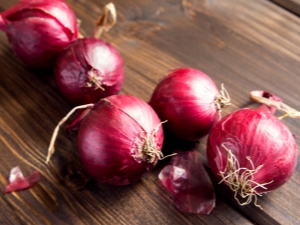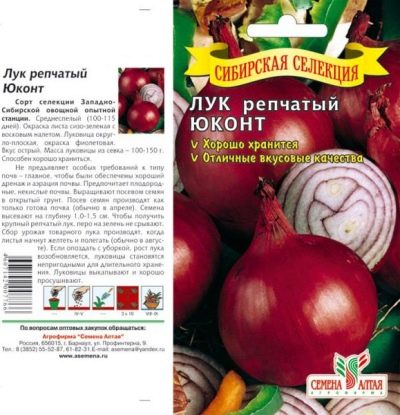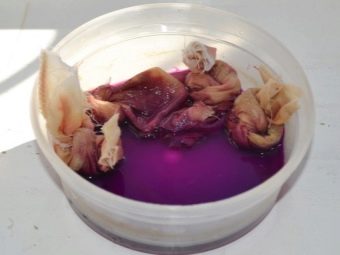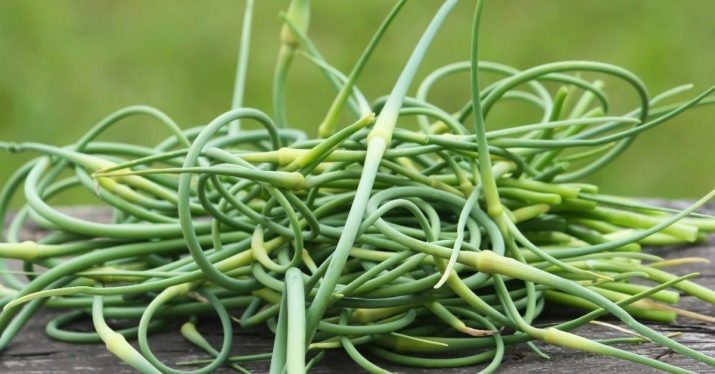Red onions: properties, cultivation and application

What is a red onion and how does it differ from the usual? Is it really sweet? These and many other issues are occupied by gardeners who planted planting such onions.
Description
Red onions belong to the Onion family. It is called so because of the bright color of the husk, the shade of which can be from pale to rich burgundy. The inner part has, rather, a purple hue. Like other onions, it has a low calorie content (per 100 grams of product). Nutritional value - 42 kcal, most of it falls on carbohydrates.Their content - 9.2 g, proteins - 1.7 g, fat - 0.1 g.
In appearance and taste characteristics of a purple vegetable is different from white and yellow. The first difference - in the bright husk and purple-red shade of pulp. Red onion is less burning, does not burn the mucous, it is sweeter and more tender compared to the universal yellow. This, in turn, led to its frequent fresh consumption - it is usually put in salads.
White onions are characterized by a greater sweetness compared to the universal. It is similar to sweet varieties of red onions, but, unlike him, has no sharp varieties. White onions have the lowest shelf life compared with the species considered.
However, it is completely unfair to assume that a purple vegetable can only have a sweet taste. Depending on the variety and the characteristics of cultivation, red onions can have both sharpness and bitterness.
Red onions are considered a two-year grassy plant. The diameter of the bulb is 12-15 cm. The mass of the head is 65-76 g. The buds are formed on the stem, from which the daughter bulbs then develop.
In general, the taste of red onion depends on its variety, place of cultivation and care. So, the sweetest is the Crimean red onions, which the inhabitants of the Crimea eat separately from other dishes. This variety, grown in the area between Yalta and Alushta, is a delicacy.
Benefit and harm
The beneficial properties of red onions are due to its composition - it is rich in B vitamins, E vitamins, PP and ascorbic acid. In addition, it contains micro- and macroelements that are beneficial for the human body, including iron, magnesium, zinc, sodium, phosphorus, potassium, and calcium. Finally, in the vegetable there are biologically active flavonoids, in particular, allicin and quartzine.
The bright color of the vegetable is due to the presence of anthocyanins, which have antiviral and antifungal effects. In addition, it is believed that these substances are preventive in the fight against oncology, diabetes, disorders of the central nervous system. Finally, they (in combination with vitamin E) suspend and slow down the aging process.
Quartcetin contained in the flavonoid composition is also very useful for the body - it, like anthocyanin, is a preventive component in the fight against cancer. It also reduces the risk of developing allergies, edema and cramps.
Sulfur has a rejuvenating effect and sulfur, which is rich in red-violet vegetables in various compounds. Sulfur has the ability to remove toxins from the body, stimulates the synthesis of collagen, which, in turn, is responsible for the elasticity of the skin, has a positive effect on the hair and nails. By the way, the last action is due to the presence of zinc in the vegetable.
Finally, sulfur contributes to the healing of blood vessels, since it destroys and prevents the appearance of new cholesterol plaques on the vascular walls. This reduces the risk of developing varicose veins, heart attacks, strokes, tissues and organs receive the necessary amount of oxygen.
Rich in vitamin C, red onions will help in the fight against colds and vitamin deficiency. It helps to strengthen the immune forces of the body. It must be included in the diet during the period of seasonal respiratory diseases, as well as in late winter-early spring. In addition, purple onion juice has a disinfecting effect, which allows you to destroy bacteria and viruses.
The disinfecting effect is combined with the antihelminthic, so the onions are often used as a means of combating parasites. Regular consumption of vegetables is the prevention of such troubles.
Researches prove that a vegetable promotes the production of testosterone, increases libido. Men are advised to add it to their usual dishes.
The opinion that red onions have a sweetish taste due to the presence of sugar is considered to be erroneous. This is not so, the bitterness of onions is due to the content of essential oils in it.The greater their number, the sharper and "tearful" is a vegetable. In sweet varieties, the amount of these essential oils is minimal.
Due to the high content of essential oils and acids, onion consumption should be abandoned during the period of exacerbation of gastrointestinal diseases (gastritis, ulcers, pancreatitis). In the presence of chronic diseases of these organs should also reduce the amount of consumed red onions.
If you are hypersensitive, you cannot eat a vegetable. It is necessary to refuse its consumption in case of liver and kidney diseases, as well as in the acute form of diseases of the urinary system. For asthma and hypertension, red onions should be carefully included in your diet.
For pregnant women, a red vegetable is useful in that it contains folic acid, so necessary for the normal development of the fetus. In addition, due to the content of B vitamins, onions have a beneficial effect on the nervous system, normalizes sleep. However, women “in position” should eat it with care and in small doses for the same reason - essential oils irritate the already vulnerable intestines and organs of the gastrointestinal tract of the future mother. In the first trimester it is allowed to consume 100 grams of onions per day, in the following - reduce to 50 g.
When breastfeeding red onions in small doses allowed to use, if it does not have negative consequences for the health of the child. Onions, including red, contribute to the formation of gases, so most nursing mothers are forced to temporarily abandon its use.
In any case, you should not eat onions in its pure form, as this can provoke heartburn, stomach pain. You can not eat onions on an empty stomach.
Persons suffering from flatulence, the red vegetable should not be eaten raw, because it is a gas-forming product.
Sorta
There are several varieties of this onion, one of the most famous of which is the Crimean onion. It is so sweet that the inhabitants of the peninsula consume it like apples. As already mentioned, this variety of onions was originally grown in the area between Alushta and Yalta. In this case, he gets unprecedented sweetness and juiciness. Onion heads are rather large, they are used fresh in a salad, and caramelized and served as a dessert.
The sweet and bitter taste is different "Red Baron". It is distinguished by a high content of ascorbic acid, as well as the ability to be stored for a long time, maintaining the same taste and composition. Such bulbs are universal - they are eaten fresh, used to prepare first and second courses, sauces.
Another variety that can be stored for a long time is Brunswick. Refers to late ripening, onion heads are medium sized flat "balls". Good performance and demonstrates a good red onion "Great Autumn Red F1". It is also distinguished by rather large onions, the mass of which can reach 130-140 g. By the way, it can be found on the windows of most supermarkets - it tolerates long-term transportation, is long stored and has a pleasant sweetish taste.
If you want to start feasting on red onions in early August, choose early ripe varieties, such as the “Red Ball”, which is also famous for its high yield. From the name of the variety it is clear that the harvest has the shape of a regular circle and a rich purple hue. It is best to consume this variety fresh.
For growing on your own plot, especially if you are new to this business, you can recommend the variety Campillo F1, which is relatively unpretentious in its care and resistant to cultural diseases. The harvest will please with a beautiful violet shade and delicate taste.
The resemblance and the same sweet taste as that of Campillo F1, reveals Retro onions. This early ripe variety is optimal for fresh salads. Thanks to the sweetness of the bulbs, they can even be used in dishes for children.By the way, the “Retro” variety, like the “Yukont”, is suitable for annual cultivation. The latter gives a fairly sharp crop, which can be stored for the entire winter.
A similar unpretentiousness and yield is demonstrated by the “Red Semko F1”, which produces flat bulbs of medium size. If you compare it with blue and purple varieties, then in the section it has white flesh with red stains on the edges of the rings.
But lovers of red onions with a pleasant bitterness will probably like Red Branunschweig, which is middle-ripe. The advantage of it is a friendly germination, non-accidents in the growing season. The variety "Black Prince" surprises with a rich dark red, turning into burgundy, shade. It has a semi-sharp taste, demonstrates good keeping quality and versatility.
Planting and care
The taste and sweetness of the onion is largely dependent on the characteristics of the soil and temperature conditions. Since the culture participates in the crop rotation, the best soils for it will be those on which solanaceae were grown before - tomatoes, potatoes, zucchini.
You should choose well-ventilated (but windless) areas, most of the day covered by the sun. It is necessary to be engaged in preparing the soil in autumn - to dig, to make organic and mineral fertilizers. In the spring, the soil is re-digging. Best of all, red onion grows on fertile sandy soil.
Planting onions can be divided into 2 stages - planting onion seeds in a greenhouse, and after the emergence of seed from these seeds, transplant it into a flower bed and further cultivation. You can buy sevok and immediately plant it in a garden bed, but the probability of buying seed that is unstable to infections is so high. Negligent vendors often confuse onions, which is why the variety that a gardener expects to grow does not grow.
Onion seeds should be sorted out, removing empty and defective, and then sanitized in a weak solution of potassium permanganate. To do this, in a glass of warm water should be dissolved 1 g of potassium permanganate. In this solution, you need to withstand the seeds for 15-20 minutes, then rinse under water and dry. It is more convenient to wrap the seeds in a gauze bag.
Prepared seeds in early spring are planted in the ground in a greenhouse or at home under the film. For the emergence of shoots it is necessary that the temperature of the medium was at least 25 degrees.
After collecting the seeding, it is disinfected again, soaked in a non-strong solution of potassium permanganate, the tops cut off (this improves growth) and planted in open ground. You can not plant weak, damaged by rot or disease onions. By this time, the night frost should stop, and the soil temperature should be at least 15-17 degrees.
Usually, red onions are grown on beds, after making furrows every 20–25 cm on their surface. The spacing between the onions is 4–5 cm.
Popular is the "Chinese" method of growing red onions, according to which you need to make high beds. The latter after a while under the influence of rain are washed out, and the upper part of the bulb (which has already managed to get stronger and adapt) opens. In this form, the plant receives more solar heat and light, nutrient components, which has a beneficial effect on its growth.
Further care of the plant can not be called difficult, but to get a good harvest It is important to regularly implement the following agrotechnical recommendations:
- Weeding. Because weeds take away nutrients, they can cause a crop disease. Weeds uprooted can not be left on the beds or near it, it attracts parasites, causes rot.
- Loosening the soil, which provides aeration of the soil. This, in turn, improves the air exchange, prevents stagnation of moisture in the soil, and allows the bulb to receive more light and heat.
- Fertilization - during the growing season will need to fertilize the plant twice. The first time is at the stage of bulb formation using organic fertilizers.The second - after 2-3 weeks, using pure wood ash.
- Watering - lack of moisture causes yellowing of onion feathers, makes the crop bitter. However, excess moisture can destroy the crop. The optimal schedule is once every 5-7 days, taking into account the climatic conditions of the region. As a rule, at the beginning of development, red onions require more frequent watering than at the end of the growing season.
Evidence that the bow is ready for harvest will be yellowing and lodging of the green arrows. It is important not to let the onions bloom, because its harvest can not be stored. If you find these arrows in the garden, pull out the bow and soon use it as food.
Learn more about how to grow red onions, you will learn from the following video.
Storage Recommendations
The harvest should be dried during the day, without folding it, however, under direct sunlight. Optimal harvest in the morning (always in dry weather) and put to dry, for example, under a canopy until the evening.
After that, cut off the arrows (if this has not been done previously), leaving them 5-7 cm, tie several bulbs together “in a bunch”, which should be suspended in a well-ventilated, UV-protected place. In this form, onions should be dried for 2-3 weeks, then inspect, trim dry arrows, leaving a 2-2.5 cm "tail".
Now onions can be shifted to the boxes, boxes for further storage. If you plan to store onions all winter until next season, it is important to choose a suitable variety that is distinguished by good keeping quality. For example, the Yalta red onion is not very suitable for these purposes, since it is stored for no more than four months.
It is important to provide optimal temperature conditions. The permissible storage temperature range is -3 ... +10 degrees. Sweet red onions are best kept at 0 degrees.
Another important condition is good ventilation. Finally, the humidity should not exceed 80%. If one of these requirements is not observed, the onion begins to deteriorate rapidly, losing its taste and benefits.
Do not store onions in plastic bags. Preference should be given to wooden boxes, wicker baskets, cardboard boxes, fabric bags.
For storage, you can use the cellar. If we are talking about storage in the conditions of the apartment, fit the shelves on the mezzanine, the balcony, where the temperature in winter does not fall below 0, as well as the lower shelves of the refrigerator. It is possible to lay heads in the old-fashioned way in nylon panty hoses or stockings. In this form, the bow will be protected from moisture, and air circulation will not be disturbed.
Before storing the vegetable for storage, it should be well dried and the damaged, prone to rotting heads should be removed.
Vegetable use
The onion preserved in the right conditions always remains juicy and sweet. It can be fried, pickled, put in salads. Interesting to taste is obtained sauce from this vegetable. Sweet and sour addition to the main dish is especially well combined with meat, stewed vegetables.
Sweet, with a slight bitterness of a grade usually used for vegetable and meat salads. They go well with tomatoes, basil, soft cheeses, veal, poultry.
Red onions are also suitable for treatment. As a rule, we are talking about juice, which is rubbed into the scalp for baldness, drink on an empty stomach in small quantities when dealing with worms. Baked and mixed with honey, the bulb is used for colds. Freshly grated onion gruel is applied to calluses and corns to soften them.








































